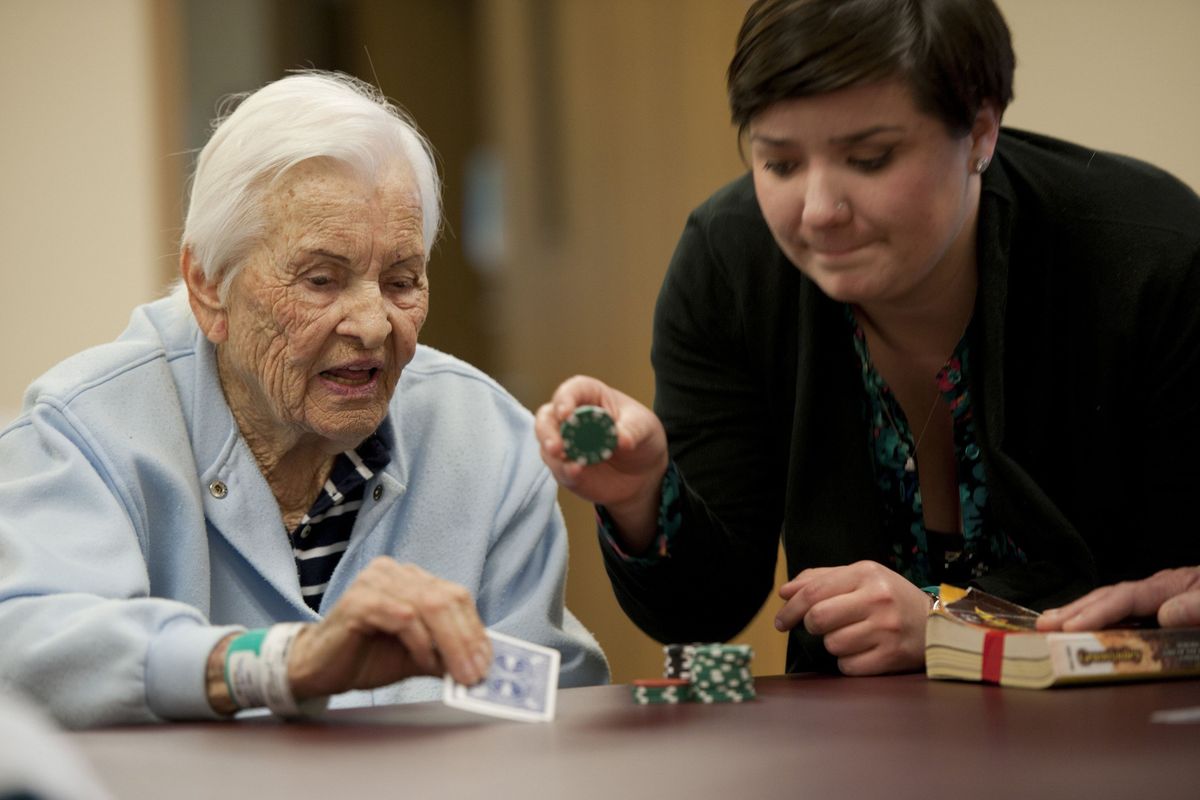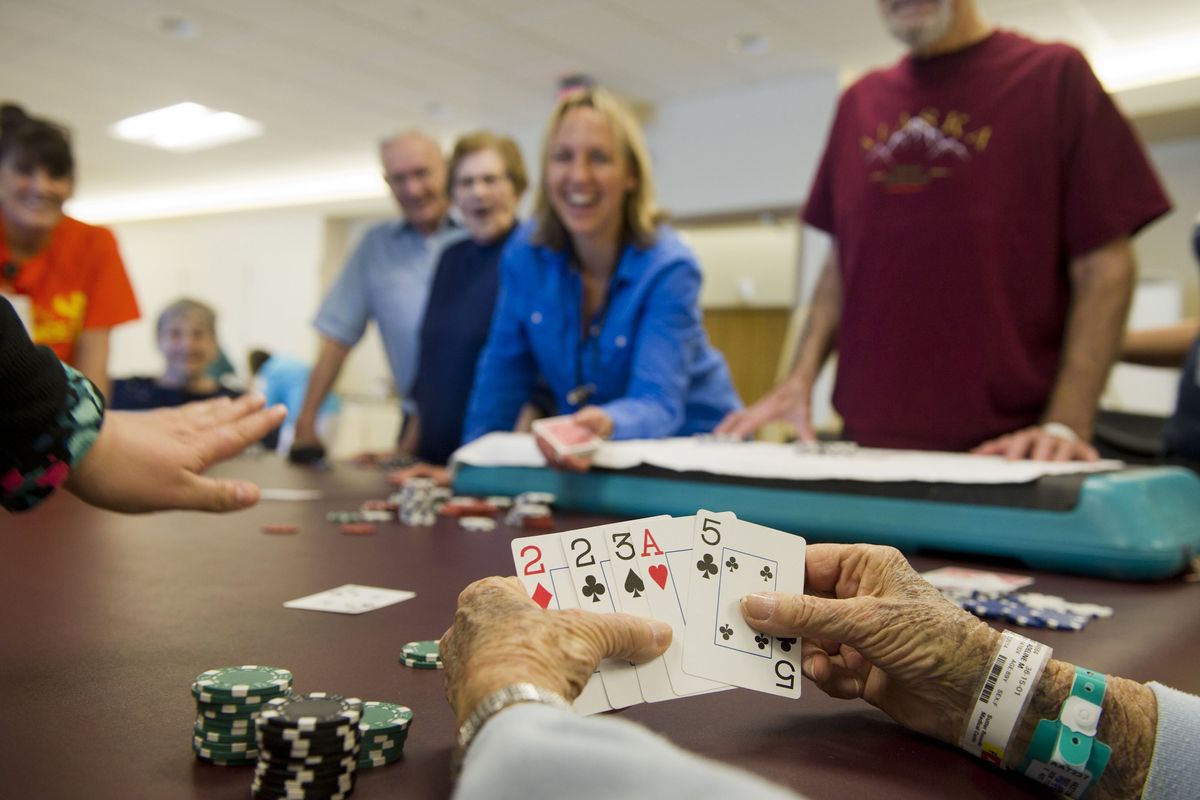Study finds sense of well-being often improves with age
Adele Best, 89, plays blackjack with help from recreational therapist intern Cherie Lundgren at the Sutter Rehabilitation Institute in Roseville, Calif.
Marge Gorman and Gordon Sims, an active retired couple, had invited people over for a Super Bowl party at their home in Sacramento. A few days before the game, Gorman fell in the bathroom. She fainted, hitting her head on the doorjamb and suffering a spinal injury.
“I couldn’t feel my arms or legs,” said Gorman, 69, a retired state employee. “I wake up, and I’m blind. I can’t see anything. It felt like I was a pretzel.”
Her sight returned during her weeklong hospital stay, but she regained only partial use of her limbs. Then came several weeks of intense therapy at Sutter Rehabilitation Institute in Roseville, Calif., and a grueling but successful operation to fuse her neck vertebrae. Outpatient physical therapy to help her regain the use of her limbs is expected to last up to nine months.
“This has been a bump in the road,” said Gorman, who’s also a breast cancer survivor. “A big bump. It’s slowed me down. I do have to be brave, but we do what we have to do.”
Experts call that positive attitude the paradox of aging: Although growing older increases the likelihood that people will deal with physical limitations, chronic illness and grieving the loss of loved ones, research shows that aging generally also increases the likelihood of optimism.
Emotional resilience plays a critical role in helping older adults weather difficulties.
Interestingly, the hardships of aging are more easily quantified than the happiness. Although people are living longer than ever, 80 percent of people 65 and older have at least one chronic illness, according to the U.S. Centers for Disease Control and Prevention, and 50 percent have two or more. Almost 15 percent of elderly Americans require assistance with the basic activities such as bathing and preparing meals, according to the federal Agency for Healthcare Research and Quality.
Despite a gradual loss of independence, they’re coping: Only 10 percent of older adults are dealing with depression, according to the CDC. What’s more, a growing body of research shows that people’s sense of well-being tends to rise after the hectic midlife years – and it keeps rising as people grow older, even in the face of physical challenges.
American Psychological Association findings consistently show that mental health in general improves with age, partly because many older adults have learned to avoid unnecessary stresses and dramas and instead concentrate on good times and happier memories.
The secret to their contentment is that simple: They don’t dwell on the bad.
“There are neural changes,” said Mario Garrett, a San Diego State University gerontology professor and a blogger on aging for Psychology Today. “Older adults’ brains rewire to look at positive things, so we remember more positive things, and we put value on those positive experiences.
“And the linchpin for all that is that older adults accept what is happening to them. Older adults flourish in the midst of diminished capacity through accepting those changes and realizing that those changes are what makes them who they are.”
Acceptance of the aging process helps build the emotional resilience that allows older adults to cope, according to a 2012 report by Arizona State University researchers: Seniors who accept the physical and emotional wear and tear of their years are better able to bounce back from illness and crisis and cope with adversities. Other keys to emotional resilience include maintaining family ties and social connections, and feeling a sense of purpose.
“Not only does it take courage for older adults to confront those hard situations, it takes wisdom to focus on what’s important,” said AARP California spokesman Mark Beach. “It means understanding what’s important and what you have the power to change and what you have to accept.”
But the challenges can be daunting. While AARP research shows that 90 percent of older adults prefer to remain independent, living in their own homes, doing so becomes much harder after a heart attack or stroke leaves them weak, or a fall causes spinal damage.
At Sutter Rehabilitation Institute, patients average 67 years old. About a third are recovering from stroke. Osteoporosis, falls, arthritis and joint replacement account for almost half of the center’s patients, said its medical director, Dr. Adora Matthews.
The best indicator of a patient’s chances for a successful rehabilitation – enduring physical and occupational therapy to relearn how to walk or raise a fork – involves the strength of the patient’s support system, she said.
“People with a strong support system tend to be more adaptable and less depressed. If they have people they can lean on, they tend to rally very well,” Matthews said. “For geriatric patients, their life experience helps a lot.”
Marge Gorman was widowed in 2002 and not long after met her partner, Gordon Sims, a retired federal worker who’s now 81. They travel and spend time volunteering, partly through the Widowed Persons Association of California.
And Gorman paints. After retiring in the mid-1990s, she devoted herself to artistic pursuits. She took lessons in doll-making, eventually teaching classes herself. And she began to create watercolors, again taking classes, then entering art shows.
“It’s just a joy,” she said of painting. “You put your heart and soul into it.”
Recreational therapist Alyssa Rose worked with Gorman during her three-week stay so she could hold a paintbrush steady in her right hand, using her left hand part of the time.
“I don’t want to see people limit what they do for leisure,” Rose said. “We see seniors who’ve had active lifestyles, and now they’ve had this life-altering event. How do they return to the activities that have meaning and purpose for them? We focus on that quality of life.”
That’s what Gorman is focusing on now, too, as she recuperates from surgery.
“I’ve volunteered for everything in the past,” she said, “and I’m not going to do that anymore. I’m slowing down, because I need to. But I’ll still do my watercolor classes.”
She uses a walker now and relies on Sims to cook, help her get dressed and drive her to medical appointments. They’re adjusting to their new reality together.
“You can’t let it whip you,” Sims said.”
Gorman agreed.
“You go through hardships, and you pull up your bootstraps,” she said. “And you keep on going.”

